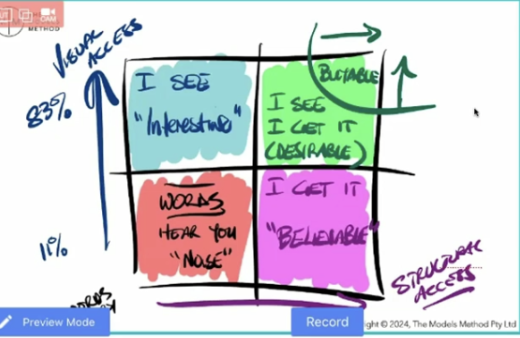In this week’s edition of Impactful Teamwork, my guest Simon Bowen, founder of the Models Method shared a brilliant insight: Words alone often fail. Relying purely on language is risky because:
- It depends on each person’s vocabulary and interpretation.
- People “hear” but don’t always “understand.”
Action Point: Whenever you communicate complex ideas with your team, pair your words with a simple visual or structure. This could be a basic two-by-two matrix, a diagram, or even a simple flowchart.
Remember:
- Visuals = “I see.”
- Structure = “I get it.”
- When people both “see” and “get it,” they feel engaged and aligned.
The “Green Zone” of Communication
Simon introduced the concept of a two-by-two matrix where effective communication sits in the “green zone” — the top right quadrant where information is both visually engaging and structurally clear.
- Visual access makes communication interesting.
- Structural access makes communication believable.
- When you combine both, your ideas become desirable and even viable.
Action Point: Next time you’re preparing for a meeting or presentation, think about:
- What can I show visually?
- How can I organize it structurally?
Even a rough sketch can make a huge difference!
Leadership Is a Performance Art: The Power of Choreography
Simon emphasized that every leadership communication is a performance. It’s not about being extroverted — it’s about choreographing your communication for maximum impact.
Drawing on lessons from stage magic and comedy, he explained:
- Great leaders set up clear “pathways”.
- They deliver “punchlines” that reveal new perspectives.
- They trigger curiosity — keeping their teams engaged and wanting more.
Action Point: Think about the “story arc” of your next team conversation.
- What “setup” are you creating?
- What “aha moment” or “reveal” can you deliver?
Curiosity is one of the most powerful levers you can pull as a leader.
The Four “C’s” of Leadership
Simon beautifully framed leadership around four key elements:
- Character — Your character enters the room before you do.
- Communication — Clear communication builds believability.
- Commitment — Your commitment inspires accountability.
- Courage — Your courage fuels your team’s confidence.
Action Point: Reflect on these four areas.
- Where are you strongest?
- Where could you improve?
Leadership isn’t about having all the answers — it’s about how you show up every day.
Purpose and Values: The Foundation for Shared Leadership
In today’s complex and chaotic world, leadership can (and should) be shared within teams. But for shared leadership to work, the organization must:
- Have a clear, compelling, self-evident purpose.
- Define values that truly matter — not just baseline values like “trust” or “respect,” but the ones that make your team uniquely you.
Action Point:
- Ask yourself (and your team): If our company disappeared for six months, who would suffer and why?
- Clarify not just “what” you do, but why it matters to the world.
And when defining values, go beyond generic statements. Identify values that demand real behavior and actions every day.
The Superpower of Pause and Deep Thinking
One of the most profound reminders from Simon was that we’ve engineered pause out of the modern world.
To be great leaders, we must create intentional space for deep thinking, reflection, and model-building.
Action Point:
- Block regular “thinking time” into your calendar.
- If you catch yourself staring into space, grab a notepad and start sketching your thoughts — create a model!
Bonus Tip: When someone asks what you’re doing, say “I’m building a model to unpack a concept.” It instantly shifts perceptions: you’re seen as a deep, strategic thinker.
Final Reflections
Leadership isn’t a right — it’s a responsibility. It demands character, communication, commitment, and courage. It’s about guiding your team through chaos safely, anchoring them to purpose, values, and a shared vision.
As Simon so beautifully put it: “Business should be a noble enterprise.”
Let’s step up to create the kind of leadership that the world so desperately needs.
S
Show Notes
00:00 Introduction and Guest Welcome
02:01 The Importance of Models in Communication
04:13 Visual and Structural Access in Communication
12:16 The Role of Leadership in Effective Communication
14:34 Character and Communication in Leadership
20:19 Shared Leadership and Organizational Purpose
24:03 Balancing Commercial and Cause in Organizations
25:23 The Importance of Purpose and Impact
27:20 Defining and Living Organizational Values
29:17 The Role of Kindness in Company Culture
32:43 Analog Humans in a Digital World
34:51 The Power of Pause and Deep Thinking
37:56 Leadership and Teamwork Insights
38:20 Conclusion and Resources
Next Steps:
- Visit www.modelsmethod.com to access Simon’s incredible free resources.
- Sign up for his “20 Minute Teaching” sessions — now available for UK and Europe time zones too!
- Reflect on your own communication: Are you operating in the “green zone”?
- Start sketching simple models to communicate key ideas with your team.
Thank you, Simon, for sharing your genius with us — and thank YOU for tuning in to Impactful Teamwork. See you next week!





